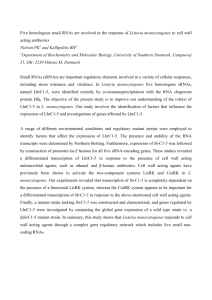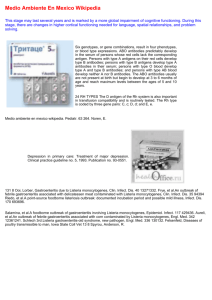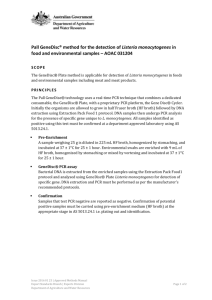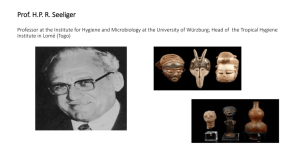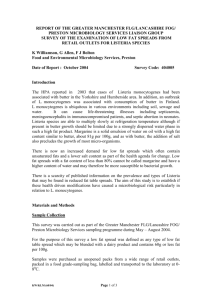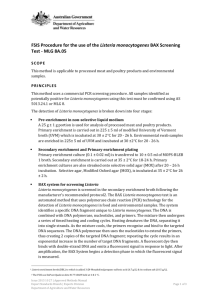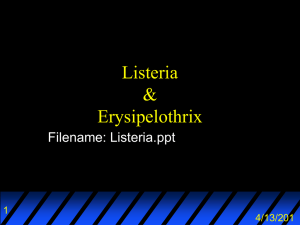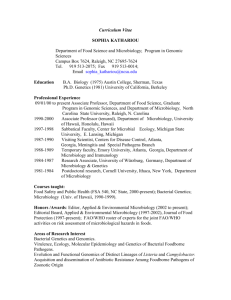Chapter 15: Listeria monocytogenes
advertisement
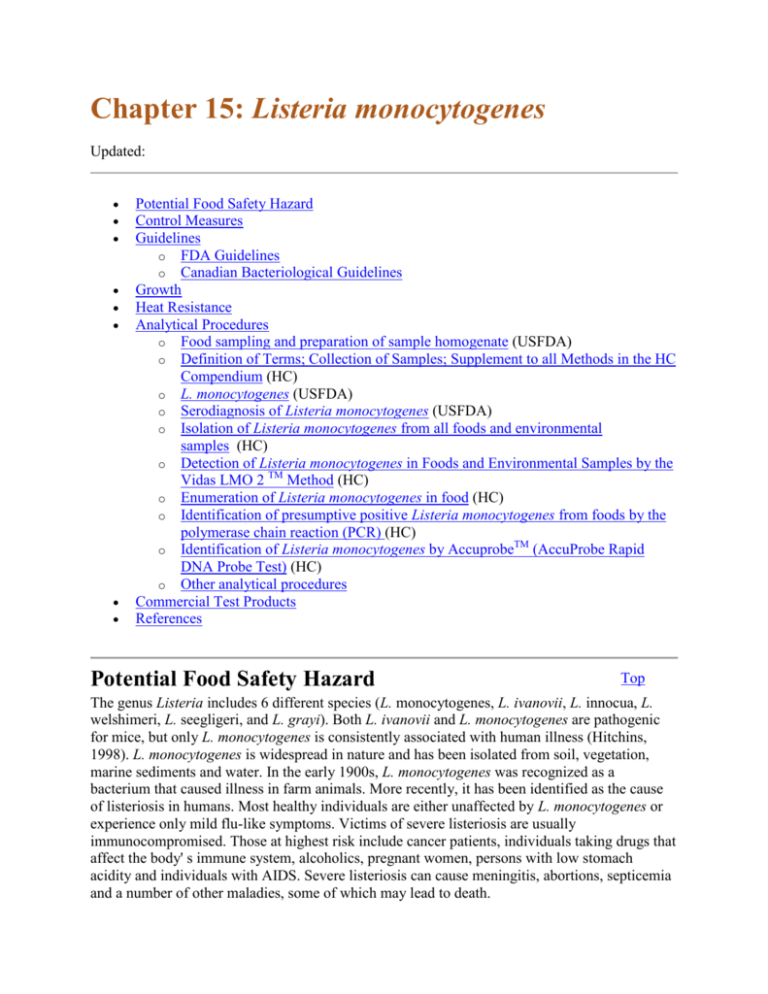
Chapter 15: Listeria monocytogenes Updated: Potential Food Safety Hazard Control Measures Guidelines o FDA Guidelines o Canadian Bacteriological Guidelines Growth Heat Resistance Analytical Procedures o Food sampling and preparation of sample homogenate (USFDA) o Definition of Terms; Collection of Samples; Supplement to all Methods in the HC Compendium (HC) o L. monocytogenes (USFDA) o Serodiagnosis of Listeria monocytogenes (USFDA) o Isolation of Listeria monocytogenes from all foods and environmental samples (HC) o Detection of Listeria monocytogenes in Foods and Environmental Samples by the Vidas LMO 2 TM Method (HC) o Enumeration of Listeria monocytogenes in food (HC) o Identification of presumptive positive Listeria monocytogenes from foods by the polymerase chain reaction (PCR) (HC) TM o Identification of Listeria monocytogenes by Accuprobe (AccuProbe Rapid DNA Probe Test) (HC) o Other analytical procedures Commercial Test Products References Potential Food Safety Hazard Top The genus Listeria includes 6 different species (L. monocytogenes, L. ivanovii, L. innocua, L. welshimeri, L. seegligeri, and L. grayi). Both L. ivanovii and L. monocytogenes are pathogenic for mice, but only L. monocytogenes is consistently associated with human illness (Hitchins, 1998). L. monocytogenes is widespread in nature and has been isolated from soil, vegetation, marine sediments and water. In the early 1900s, L. monocytogenes was recognized as a bacterium that caused illness in farm animals. More recently, it has been identified as the cause of listeriosis in humans. Most healthy individuals are either unaffected by L. monocytogenes or experience only mild flu-like symptoms. Victims of severe listeriosis are usually immunocompromised. Those at highest risk include cancer patients, individuals taking drugs that affect the body' s immune system, alcoholics, pregnant women, persons with low stomach acidity and individuals with AIDS. Severe listeriosis can cause meningitis, abortions, septicemia and a number of other maladies, some of which may lead to death. The greatest threat of listeriosis is from ready-to-eat products that do not require further cooking at home. L. monocytogenes in raw food that will be cooked before consumption is less of a concern to the food industry since the bacteria are killed during cooking. L. monocytogenes has been isolated from raw fish, cooked crabs, raw and cooked shrimp, raw lobster, surimi and smoked fish (Ward et al., 1997). Control Measures Top Hazards from L. monocytogenes can be prevented by thoroughly cooking seafood and by preventing cross-contamination once the seafood is cooked. Since the infective dose of L. monocytogenes is thought to be small, time/ temperature abuse of food products may not be necessary to result in illness (Ward et al., 1997). Guidelines Top FDA Guidelines Top FDA & EPA safety levels in regulations and guidance. Canadian Food Inspection Agency Bacteriological Guidelines for Fish and Fish Products Top Growth Top Table A-1. Limiting conditions for pathogen growth. Heat Resistance Top Heat resistance of L. monocytogenes. Temp. (ºC) (ºF) D-Value (min) Medium Blue crabmeat Reference Harrison and Huang, 1990 40.43 Blue crabmeat Harrison and Huang, 1990 125 97.0 Lobster Budu-Amoako et al., 1992 130 55.0 Lobster Budu-Amoako et al., 1992 55 131 9.18 Blue crabmeat Harrison and Huang, 1990 55 131 12.00 Blue crabmeat Harrison and Huang, 1990 55 131 10.23 Crawfish tail meat Dorsa et al., 1993 56 132.8 48.09 Mussels, brine Bremer and Osborne, 1995 soaked 50 122 34.48 50 122 51.6 54.4 57.2 135 8.3 58 136.4 16.25 Lobster meat Budu-Amoako et al., 1992 58 136.4 10.73 Salmon Embarek, 1995 58 136.4 7.28 Cod Embarek, 1995 59 138.2 9.45 Mussels, brine Bremer and Osborne, 1995 soaked 60 140 2.39 Lobster meat Budu-Amoako et al., 1992 60 140 1.31 Blue crabmeat Harrison and Huang, 1990 60 140 2.61 Blue crabmeat Harrison and Huang, 1990 60 140 1.98 Crawfish tail meat Dorsa et al., 1993 60 140 5.49 Mussels, brine Bremer and Osborne, 1995 soaked 60 140 4.48 Salmon Embarek, 1995 60 140 1.98 Cod Embarek, 1995 62 143.6 1.85 62 143.6 2.07 Salmon Embarek, 1995 62 143.6 0.87 Cod Embarek, 1995 62.7 145 1.06 Lobster meat Budu-Amoako et al., 1992 65 149 0.19 Crawfish tail meat Dorsa et al., 1993 65 149 0.87 Salmon Embarek, 1995 65 149 0.28 Cod Embarek, 1995 68 154.4 0.15 Salmon Embarek, 1995 68 154.4 0.15 Cod Embarek, 1995 70 158 0.07 Salmon Embarek, 1995 70 158 0.03 Cod Embarek, 1995 Mussels, brine Bremer and Osborne, 1995 soaked Mussels, brine Bremer and Osborne, 1995 soaked Z-values: lobster meat 5.0ºc, blue crabmeat 8.40ºc in trypticase soy agar, crawfish tail meat 5.5ºc, mussels 4.25ºc, salmon 5.6ºc, cod 5.7ºc. Analytical Procedures Top BAM: Detection and enumeration of L. monocytogenes (US FDA) Top Food sampling and preparation of sample homogenate (US FDA) Top Serodiagnosis of Listeria monocytogenes (US FDA) Top Summary of Methods to detect the presence of Listeria spp. and Listeria monocytogenes (HC) Top Other analytical methods Top Listeria monocytogenes in Milk and Dairy Products: Selective Enrichment and Isolation Method (AOAC, 1995a) Listeria Species: Biochemical Identification Method (Vitek GPI and GNI) (AOAC, 1995b) Listeria in Dairy Products, Seafoods, and Meats: Colorimetric Deoxyribonucleic Acidhybridization Method (GENE-TRAK Listeria Assay) (AOAC, 1995c) Listeria monocytogenes in Dairy Products, Seafoods, and Meats: Colorimetric Monoclonal Enzyme-linked Immunosorbent Assay Method (AOAC, 1995d) Listeria in Foods, Colorimetric Polyclonal Enzyme Immunoassay Screening Method (TECRA Listeria Visual Immunoassay) (AOAC, 1995e) Listeria Species: Biochemical Identification Method (MICRO-ID Listeria) (AOAC, 1995f) Commercial Test Products Commercial test products for L. monocytogenes. Analytical Test Technique AccuPROBE® Nucleic acid Listeria hybridization monocytogenes Culture Identification Test API LISTERIA Biochemical [Used to reactions identify Listeria spp.] Approx. Total Test Time1 Supplier 18-48 h Gen-Probe Web: www.gen-probe.com 18-24 h bioMérieux Inc. Web: www.biomerieux.com Assurance Enzyme Listeria EIA2 immunoassay [Used to identify Listeria spp. including L. monocytogenes] 50 h BioControl Systems, Inc. Contact: Robin Forgey 12822 SE 32nd St. Bellevue, WA 98005 Phone: 800/245-0113; 425/6031123 E-mail: info@rapidmethods.com Web: www.rapidmethods.com BAX® for Polymerase chain Genus Listeria reaction 45 h Qualicon, Inc. P.O. Box 80357 Wilmington, DE 19880-0357 Phone: 800/863-6842; 302/6959400 E-mail: info@qualicon.com Web: www.qualicon.com BAX® for Polymerase chain Screening/L. reaction monocytogenes 45 h Qualicon, Inc. P.O. Box 80357 Wilmington, DE 19880-0357 Phone: 800/863-6842; 302/6959400 E-mail: info@qualicon.com Top Web: www.qualicon.com Chromogenic Listeria [A differentiation test for Listeria monocytogenes and other species.] 42-66 h Biomedix Contact: Claver Bundac 1105 #F North Golden Springs Dr. Diamond Bar, CA 91765 Phone: 800/674-8648 #4282; 909/396-0244 E-mail: cb4biomedx@aol.com Dynabeads Immunomagnetic anti-Listeria Separation [Used to identify L. monocytogenes] 48 h Dynal Inc. Contact: Technical Service 5 Delaware Dr. Lake Success, NY 1042 Phone: 516/326-3270 E-mail: techserv@dynalusa.attmail.com Web: www.dynal.no/ EIAFoss Listeria 48 h Foss North America, Inc. 7682 Executive Dr. Eden Prairie, MN 55344 Phone: 612/974-9892 E-mail: sales@fossnorthamerica.com Web: www.fossnorthamerica.com GENE-TRAK Nucleic acid Listeria hybridization monocytogenes Assay 48 h Neogen Corporation 620 Lesher Pl. Lansing, MI 48912 Phone: 517/372-9200 E-mail: NeogenCorp@aol.com Web: www.neogen.com/genetrakback.htm GENE-TRAK Nucleic acid Listeria Species hybridization Assay2 48 h Neogen Corporation 620 Lesher Pl. Lansing, MI 48912 Phone: 517/372-9200 E-mail: NeogenCorp@aol.com Web: www.neogen.com/genetrakback.htm ISO-GRID Method for Listeria spp. Membrane filtration 24 h Neogen Corporation 620 Lesher Pl. Lansing, MI 48912 Phone: 517/372-9200 E-mail: NeogenCorp@aol.com Web: www.neogen.com/isogridgen.htm Listeria Culture 24 h Contamination Sciences LLC Contact: Robert Steinhauser 4230 East Towne Blvd., Suite 191 Madison, WI 53704 Phone: 608/825-6125 E-mail: bsteinha@contam-sci.com Web: www.contam-sci.com Listeria Rapid EIA 42 h Oxoid, Inc. Combination ELISA and immunomagnetic separation Test2 [Used to identify Listeria spp. including L. monocytogenes] Listeria-Tek ™2 Contact: Jim Bell 217 Colonnade Rd. Nepean, Ontario K2E 7K3 Canada Phone: 613/226-1318 E-mail: jbell@oxoid.ca ELISA ListerTest ™2 Immunomagnetic [Used to separation identify L. monocytogenes] Microbact 12L2 Biochemical [Used to identification identify Listeria system spp.] 48 h Organon Teknika Corp. 100 Akzo Ave. Durham, NC 27712 Phone: 800/654-0331; 919/6202000 E-mail: casey@orgtek.com 24 h Vicam, L.P. Contact: Brian Kraus 313 Pleasant St. Watertown, MA 02472 Phone: 800/338-4381 E-mail: vicam@vicam.com Web: www.vicam.com 4-24 h BioControl Systems, Inc. Contact: Robin Forgey 12822 SE 32nd St. Bellevue, WA 98005 Phone: 800/245-0113; 425/6031123 E-mail: info@rapidmethods.com Web: www.rapidmethods.com MICRO-ID Latex Listeria 2 agglutination [Used to identify Listeria spp.] 24 h Remel Contact: Customer Service 12076 Santa Fe Dr. Lenexa, KS 66206 Phone: 800/255-6730; 913/8880939 E-mail: remel@remelinc.com Web: www.remelinc.com Probelia PCR Polymerase chain System reaction [Used to identify L. monocytogenes] 30 h BioControl Systems, Inc. Contact: Robin Forgey 12822 SE 32nd St. Bellevue, WA 98005 Phone: 800/245-0113; 425/6031123 E-mail: info@rapidmethods.com Web: www.rapidmethods.com Reveal® for Sandwich ELISA Listeria2 [Used to identify Listeria spp.] 48 h Neogen Corporation 620 Lesher Pl. Lansing, MI 48912 Phone: 517/372-9200 E-mail: NeogenCorp@aol.com Web: www.neogen.com TECRA ELISA Listeria Visual Immuno Assay2 48 h International BioProducts Contact: Bob Ward 14780 NE 95th St. [Used to identify Listeria spp.] Transia Plate Listeria Redmond, WA 98052 Phone: 800/729-7611; 425/8831349 E-mail: myeager@intlbioproducts.com Web: intlbioproducts.com ELISA 48 h Diffchamb AB FO Petersons Gata 32 SE-421 31 Västra Frölunda, Sweden Phone: +46 -31-742 33 50 E-mail: market.dept@diffchamb.se Web: www.diffchamb.se Transia Plate ELISA Listeria Monocytogenes 45 h Diffchamb AB FO Petersons Gata 32 SE-421 31 Västra Frölunda, Sweden Phone: +46 -31-742 33 50 E-mail: market.dept@diffchamb.se Web: www.diffchamb.se Vidas LIS2 Enzyme linked [Used to fluorescent assay identify L. monocytogenes] 48 h bioMérieux Inc. Web: www.biomerieux.com Vidas LMO Enzyme linked [Used to fluorescent assay identify L. monocytogenes] 48 h bioMérieux Inc. Web: www.biomerieux.com VIP for Visual Listeria2 immunoprecipitate [Used to identify Listeria spp. including L. monocytogenes] 48 h BioControl Systems, Inc. Contact: Robin Forgey 12822 SE 32nd St. Bellevue, WA 98005 Phone: 425/603-1123 E-mail: info@rapidmethods.com Web: www.rapidmethods.com 1 2 Includes enrichment AOAC Approved References Top Alden, M.J., L. Marconi, J. Hogan, I.G. Rosen, and R. Johnson. 1990. A chemiluminescent DNA probe assay for the identification of Listeria monocytogenes from culture plates. Abstr. ICAAC 1990:109. AOAC. 1995a. Listeria monocytogenes in milk and dairy products: Selective enrichment and isolation method. Sec. 17.10.01, Method 993.12. In Official Methods of Analysis of AOAC International, 16th ed., P.A. Cunniff (Ed.), p. 94a-98. AOAC International, Gaithersburg, MD. AOAC, 1995b. Listeria species: Biochemical identification method (Vitek GPI and GNI). Sec. 17.10.03, Method 992.19. In Official Methods of Analysis of AOAC International, 16th ed., P.A. Cunniff (Ed.), p. 100-103. AOAC International, Gaithersburg, MD. AOAC, 1995c. Listeria in dairy products, seafoods, and meats: Colorimetric deoxyribonucleic acid-hybridization method (GENE-TRAK Listeria Assay). Sec. 17.10.04, Method 993.09. In Official Methods of Analysis of AOAC International, 16th ed., P.A. Cunniff (Ed.), p. 103-106. AOAC International, Gaithersburg, MD. AOAC, 1995d. Listeria monocytogenes in dairy products, seafoods, and meats: Colorimetric monoclonal enzyme-linked immunosorbent assay method. Sec. 17.10.05, Method 994.03. In Official Methods of Analysis of AOAC International, 16th ed., P.A. Cunniff (Ed.), p. 106-106b. AOAC International, Gaithersburg, MD. AOAC, 1995e. Listeria in foods: Colorimetric polyclonal enzyme immunoassay screening method (TECRA Listeria Visual Immunoassay). Sec 17.11.03, Method 995.22. In Official Methods of Analysis of AOAC International, 16th ed., P.A. Cunniff (Ed.). AOAC International, Gaithersburg, MD. AOAC. 1995f. Listeria species: Biochemical identification method (MICRO-ID Listeria). Sec. 17.10.02, Method 992.18. In Official Methods of Analysis of AOAC International, 16th ed., P.A. Cunniff (Ed.), p. 94a-98. AOAC International, Gaithersburg, MD. Bille, J., and M.P. Doyle. 1991. Listeriae and Erysipelothrix. In Manual of Clinical Microbiology, 5th ed. A. Balows, W.J. Hausler, Jr., K.L. Herman, H.D. Isenberg, and H.J. Shadomy (Eds.), p. 287-295. American Society for Microbiology, Washington, DC. Boeolin, P., J. Rocourt, F. Grimont, P.A.D. Grimont, C. Jacquet, and J-C. Piffaretti. 1992. L. ivanovii subsp. londoniensis subsp. novi. Int. J. Syst. Bacteriol. 42:69-73. Bremer P.J. and Osborne, C.M. 1995. Thermal-death times for Listeria monocytogenes in green shell mussels (Perna canaliculus) prepared for hot smoking. J. Food Protect. 58:604-608. Budu-Amoako, E., Toora, S., Walton, C., Ablett, R.F., and Smith, J. 1992. Thermal death times for Listeria monocytogenes in lobster meat. J. Food Protect. 55(3): 211-213. Curtis, G.D.W., R.G. Mitchell, A.F. King, and J. Emma. 1989. A selective differential medium for the isolation of Listeria monocytogenes. Lett. Appl. Microbiol. 8:95-98. Datta, A.R., B.A. Wentz, and W.E. Hill. 1987. Detection of hemolytic Listeria monocytogenes by using DNA colony hybridization. Appl. Environ. Microbiol. 53:2256-2259. Datta, A.R., B.A. Wentz, J. Lane, and M.A. Moore. 1991. Nonradioactive DNA probe hybridization assay for identification of Listeria monocytogenes. ASM Abstracts, 91:82. Dorsa, W.J., Marshall, D.L., Moody, M.W., and Hackney, C.R. 1993. Low temperature growth and thermal inactivation of Listeria monocytogenes in precooked crawfish tail meat. J. Food Protect. 56(2):106-109. Embarek, P.K.B. and Huss, H.H. 1993. Heat resistance of Listeria monocytogenes in vacuum packaged pasteurized fish fillets. Intl. J. Food Microbiol. 20:85-95. Harrison M.A. and Huang, Y. 1990. Thermal death times for Listeria monocytogenes (Scott A) in crabmeat. J. Food Protect. 53:878-880. Hitchins, A.D. 1998. Listeria monocytogenes. Ch. 10. In Food and Drug Administration Bacteriological Analytical Manual, 8th ed. (revision A), (CD-ROM version). R.L. Merker (Ed.). AOAC International, Gaithersburg, MD. Jones, D. 1992. Current classification of the genus Listeria. In Listeria 1992, p. 7-8. Abstr. ISOPOL XI, Copenhagen. Jones, D., and H.P.R. Seeliger. 1986. International Committee on Systematic Bacteriology. Subcommittee on the Taxonomy of Listeria. Int. J. Syst. Bacteriol. 36:117-118. Klinger, J.D., A. Johnson, D. Croan, P. Flynn, K. Whippie, M. Kimball, J. Lawrie, and M. Curiale. 1988. Comparative studies of a nucleic and hybridization assay for Listeria in foods. J. Assoc. Off. Anal. Chem. 71:669-673. Lee, W.H., and D. McClain. 1986. Improved L. monocytogenes selective agar. Appl. Environ. Microbiol. 52:1215-1217. Mattingly, J.A., B.T. Butman, M.C. Plank, and R.J. Durham. 1988. A rapid monoclonal antibody-based ELISA for the detection of Listeria in food products. J. Assoc. Off. Anal. Chem. 71:669-673. Merker, R.L. (Ed.). 1998. Media and reagents, Appendix 3. In Food and Drug Administration Bacteriological Analytical Manual, 8th ed. (revision A), (CD-ROM version). AOAC International, Gaithersburg, MD. Peterkin, P.I., E.S. Idziack, and A.N. Sharpe. 1991. Detection of L. monocytogenes by direct colony hybridization on hydrophobic grid membrane filters by using a chromogen-labeled DNA probe. Appl. Environ. Microbiol. 57:586-591. Rocourt, J., P. Boerlin, F. Grimont, C. Jacquet, and J.C. Piffaretti. 1992. Assignment of Listeria grayi and Listeria murrayi to a single species, Listeria grayi, with a revised description of Listeria grayi. Int. J. Syst. Bacteriol. 42:171-174. Seeliger, H.P.R. and Jones, D. 1986. Genus Listeria. In Bergey's Manual of Systematic Bacteriology, Vol. 2. P.H.A. Sneath, N.S. Mair, M.E. Sharpe, and J.G. Holt (Eds.), p. 1235-1245. Williams and Wilkins, Baltimore, MD. Stelma, G.N., Jr., A.L. Reyes, J.T. Peeler, D.W. Francis, J.M. Hunt, P.L. Spaulding, C.H. Johnson, and J. Lovett. 1987. Pathogenicity testing for L. monocytogenes using immunocompromised mice. J. Clin. Microbiol. 25:2085-2089. Van Netten, P., I. Perales, A. van de Moosdijk, G.D. Curtis, and D.A. Mossel. 1989. Liquid and solid selective differential media for the detection and enumeration of L. monocytogenes and other Listeria spp. Int. J. Food Microbiol. 8:299-316. Ward, D., Bernard, D., Collette, R., Kraemer, D., Hart, K., Price, R., and Otwell, S. (Eds.) 1997. Hazards Found in Seafoods, Appendix III. In HACCP: Hazard Analysis and Critical Control Point Training Curriculum, 2nd ed., p. 173-188. UNC-SG-96-02. North Carolina Sea Grant, Raleigh, NC. Send comments or questions to web editor .
